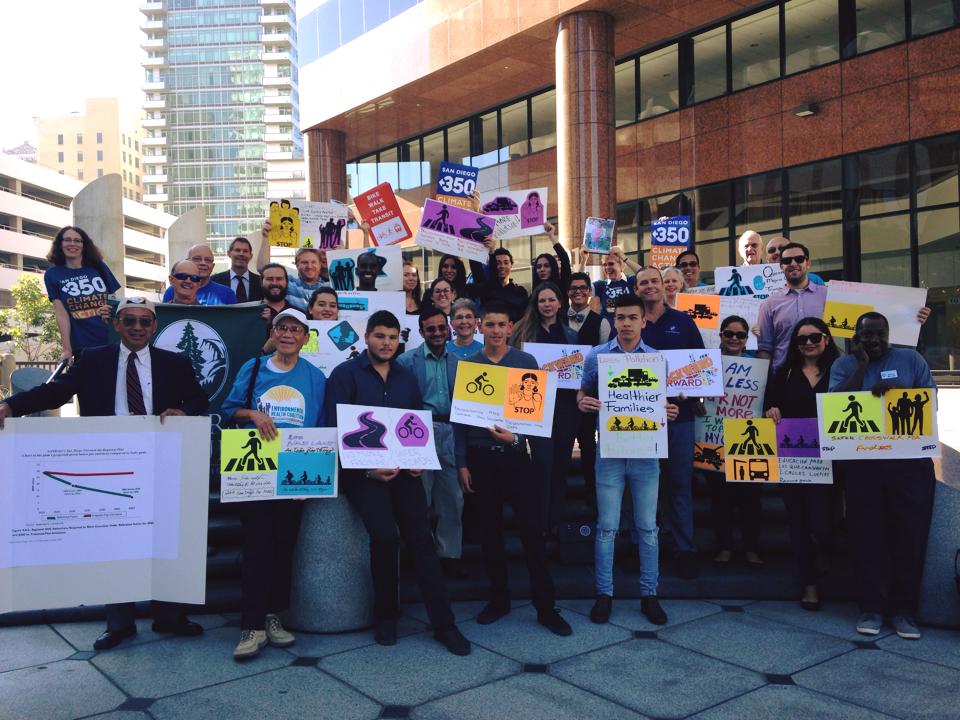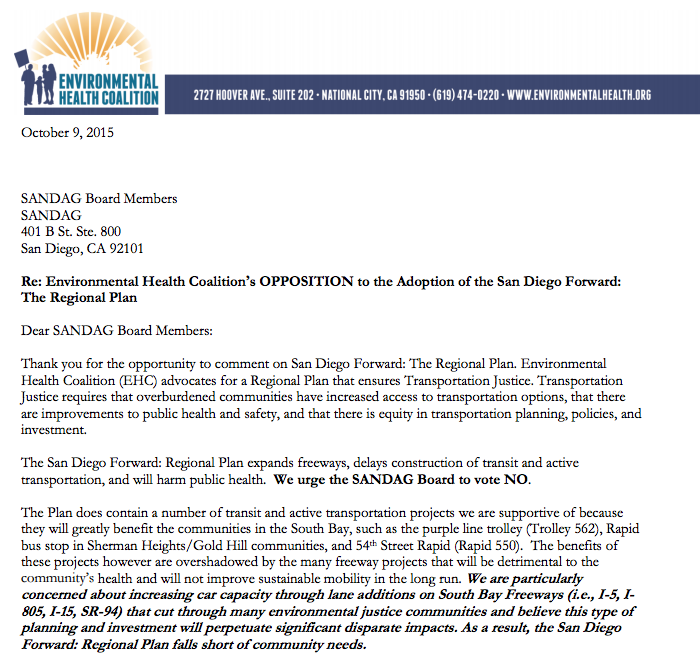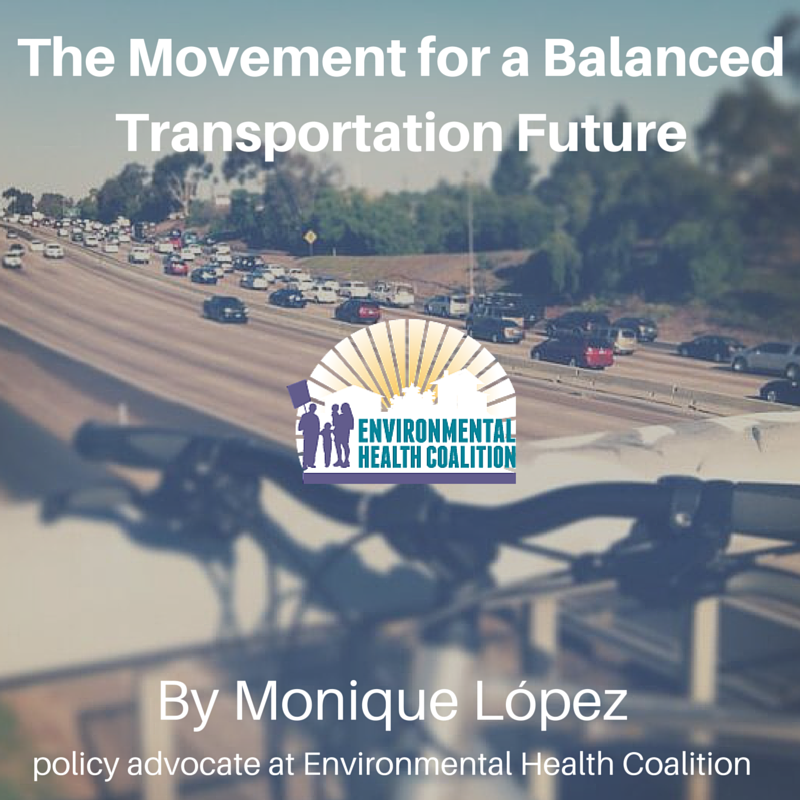The following op-ed, written by Policy Advocate Monique López, ran in San Diego Free Press on September 28, 2015.

We all need to move, and how we move influences our quality of life. The time of our commute, the safety of our sidewalks, the quality of our air and the type of transportation options we have determine how well we live our lives. On October 9, 2015, the San Diego Association of Governments (SANDAG) will decide how to invest $204 billion into our region’s transportation infrastructure.
This decision is critical to our livelihood. That much investment will have a tremendous impact on the lives of everyone in our region, particularly the lives of those in San Diego’s urban core where freeways intersect neighborhoods and transit, biking and walking infrastructure is scarce.
How these funds are invested will determine whether our region takes a step toward becoming a forward-thinking, sustainable place or whether we remain driving in circles, stuck in the incessant traffic jam that is our car-first mentality.
SANDAG’s current Regional Transportation Plan labels itself as a “balanced approach.” It claims to give equal attention to transportation options for people traveling by car as it does to those traveling by bike, bus and on foot. It claims to balance the need for better air quality with the need for efficient transportation.
In reality, SANDAG’s plan is anything but balanced.
After decades of prioritizing investment in freeway expansion and ignoring the needs of the most impacted communities, SANDAG should be investing the lion’s share of funds in underserved communities for transit and infrastructure that makes biking and walking safer.
People who live in traditionally underserved communities, including Barrio Logan, City Heights or parts of National City, Chula Vista or Imperial Beach, live with broken or nonexistent sidewalks, a lack of crosswalks to safely navigate traffic and a lack of bike lanes common in many traditionally funded communities. Residents living in a low income neighborhood in the City of San Diego, are ten times more likely to be hit by a car than those that live in most other neighborhoods. This horrifying statistic shouldn’t be a reality when we have $204 billion going toward local transportation improvements.
In San Diego, four freeways (I-5, SR-94, I-15, I-805) run through South Bay neighborhoods, and it’s no coincidence that these communities experience elevated cases of asthma, cancer and heart disease. SANDAG says it is “investing in strategies to relieve traffic congestion which causes air pollution in these communities, such as expanding freeways for carpool lanes and for transit.” This means, SANDAG plans to add freeway lanes to an already well-developed freeway, particularly in communities South of I-8.
Research shows, however, that adding more lanes doesn’t eliminate traffic congestion. This is not a solution, and not something the community wants. Building more lanes on the freeway will only lead to more cars on the road and more toxic pollution, which harms nearby communities the most. If you build it, they will drive.
Travel times between cars and public transit only furthers the obvious imbalance. In San Diego, the average commute time by car is typically 25 minutes. The same commute can take up to two or three times longer on public transit.
The Regional Transportation Plan should prioritize investment in transit to improve travel times, encouraging sustainable options and providing real travel options.
More cars driving on the road mean more fossil fuel emissions. More fossil fuel emissions mean more greenhouse gases, and more greenhouse gases mean more harmful effects of climate change.
SANDAG’s plan to expand freeways directly contradicts the City of San Diego’s Climate Plan goals to reduce local emissions and slow the effects of climate change. Instead, SANDAG should be striving to investment in transportation options that move the most people, in the most efficient, sustainable, healthy and equitable way. If SANDAG can acknowledge the glaring transportation inequality across our region and listen to the unified voice of the community, we can use our $204 billion to make everywhere in San Diego accessible and safe.
Since SANDAG passed its Regional Plan in 2011, it has received hundreds of requests from community representatives across the region, especially in the urban core, for a robust transit network and more investment in infrastructure that will make biking and walking safer in all communities. Communities have requested SANDAG refrain from continuing to add lanes to freeways that only increase the amount of cars, toxic pollution and disease without relieving traffic congestion in the long run. Despite a clear and united resident voice, there has been little-to-no movement in reprioritizing money from freeway expansion projects to transit and active transportation projects.
The 2015 Regional Plan’s freeway lane addition list looks nearly identical to the plan passed in 2011, and that is not a plan we can support.
Just imagine of what $204 billion could do to make San Diego accessible for everyone, everywhere. Where you can take public transit without spending three hours each way in a bus seat. Where you can walk your children to school on a safe sidewalk, away from street traffic. Where you can bike safely on the road with cars.
SANDAG’s plan to expand every freeway south of I-8 is an injustice. Residents in the communities most overburdened by air pollution have said enough.
Enough air pollution. Enough traffic. Enough climate change.
Environmental Health Coalition urges SANDAG to listen to the voice of community and create a truly balanced transportation plan that puts our region on the path to healthy communities.








